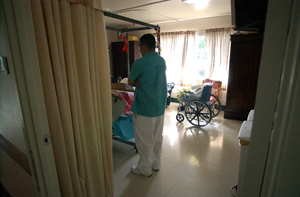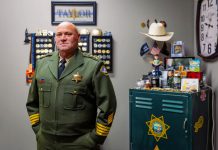
Immigrant juggles personal, work life with university
Alvaro Bonilla’s days start early and end late. By the time he
arrives for his first class of the day at San Jose State
University, he has already been up for more than four hours. He
leaves his house at 7 a.m. to start his long commute
– carpooling to Morgan Hill with his wife who works at a
preschool. She drops him at a bus stop and he takes the Valley
Transit Authority Route 68 bus to the southernmost light rail
station. The Santa Teresa line drops him in downtown San Jose and
he walks a few blocks to the campus. He has an hou
r to study in the library before his first class.
Immigrant juggles personal, work life with university
Alvaro Bonilla’s days start early and end late. By the time he arrives for his first class of the day at San Jose State University, he has already been up for more than four hours. He leaves his house at 7 a.m. to start his long commute – carpooling to Morgan Hill with his wife who works at a preschool. She drops him at a bus stop and he takes the Valley Transit Authority Route 68 bus to the southernmost light rail station. The Santa Teresa line drops him in downtown San Jose and he walks a few blocks to the campus. He has an hour to study in the library before his first class.
“On the bus I like to read the newspaper,” he said one Thursday on his way to campus. “But it was really crowded today so I couldn’t do that.”
Dressed in a gray hoodie, a white ball cap and blue jeans, Bonilla looked like a typical student lugging around a heavy backpack and judo clothes tied up in a square. He keeps his black hair closely cropped and has zero gauge pegs in his ears. But his journey to San Jose State University has not been easy.
Bonilla, 24, moved to the United States from Mexico with his mother when he was 6 years old. His father was out of the picture and his mother, who could not read or write, raised him and his younger brother. At San Juan Elementary School he learned English, though he said he still struggles with writing today. He got good grades at Anzar High School and worked to help his mother pay the bills.
He never thought about college.
“I feel she thought that high school was the best she could do and then I was on my own,” Bonilla said.
After high school he took two years off. He worked and he had fun with his friends, something he had never done when he was in school.
“But after two years I thought, do I want to be 30 or 40 and have nothing?” he said. “Just rent a room and have a crappy car? I woke up one day and decided I wanted to go to school.”
He was scared, but a close friend’s parents took him to Gavilan College and helped him enroll in courses. The family even helped pay for his first semester.
“He was a friend of our son – he’s the same age as one of our sons,” said Patrick Mullen, the father of his friend. “He’s so near and dear to us.”
The Mullen family has remained close with Bonilla through the years.
“We formed a really close bond and ever since he has really been a part of our family,” Mullen said.
Bonilla had never visited a college campus before he went to Gavilan. While there he connected with Celia Marquez, a counselor who runs the Puente Program. The program is aimed at helping students with some risk factors complete their associate’s degree and transfer to a four-year college.
Puente program offers foundation
In the first year of the program, the students are required to take an intensive English course and a course called Guidance. The guidance class teaches them about study habits, setting up course plans and about resources on campus.
“The hardest part was the academics and getting the help he needed,” said Marquez, a co-coordinator/counselor of the Gavilan College Puente Program. “He didn’t know the system and he was not very informed about the resources on campus. Everything was new to him – assignments, studying – but he was very enthusiastic about learning.”
One of the big things students learn is how to manage their time and to think about a plan for the future.
“Puente prepared me for higher education,” Bonilla said. “It helped me by laying out a plan I could follow … it taught me that college will be difficult and I was stressed, but I know to always expect the unexpected.”
One of the unexpected things for Bonilla was that his education would get in the way of personal relationships. While taking a full load of classes, he was also working full-time at Dona Esther’s Mexican restaurant in San Juan.
“I had a friend who said, ‘Why don’t you act your age? You act like a 40-year-old. All you do is go to work and school,'” he said.
Bonilla ended the friendship, but the words had stung and made him cautious about dating the woman who would become his wife.
“I was coming out of work at Dona Esther’s,” he said. “It was a busy night and I smelled like a burrito. She was coming out of a bar and asked me to come have a drink.”
He had plans to skydive the next day and declined, but she was persistent. They dated for a few weeks, and even visited California State University, Sacramento, where he had considered transferring.
“Then I got really scared because I was focusing on school,” he said. “I didn’t talk to her for two weeks.”
When he finally called her, he was surprised when she wasn’t mad. She accepted how important school was to him.
“My wife was so understanding of what education, school and studying meant to me,” he said. “I never had someone respect that.”
He is studying kinesiology in San Jose, and hopes to go into a master’s program for physical therapy after he finishes up.
“When I was a small child, my mom’s friend got injured,” he said. “He didn’t know English and I remember walking into the [physical therapy office]. It was nice and clean and they were wearing gowns. He got better by exercise.”
Balance of school, work and social life
Bonilla and his girlfriend married in July and he started classes at San Jose State in fall 2007. He took a lighter load so he could get acquainted with the campus and the resources available to him, one of which included a study group to help him pass the Writing Skills Test. Passing the test is a requirement for many upper level classes.
Mullen said he never doubted Bonilla would succeed.
“He’s a unique individual,” Mullen said. “He has a lot of self-motivation. We wanted to see the best for him and knew that education would help him in his lifetime.”
Though he only spends 14 hours a week on campus, he spends about 30 hours a week at Dona Esther’s, where he is now a bartender, and he spends at least 25 hours a week studying and doing homework, and then there are the hours he spends commuting.
In between school and work, he finds time to volunteer. He has helped with Puente outreach programs and a couple months ago sat on a panel of transfer students. He and the other students talked about their experiences with Puente, transferring and answered questions of current Puente students.
“He’s one of the students who really believes in giving back to the program,” Marquez said.
Bonilla also volunteers at the Mabie Northside Skilled Nursing Facility at least once a week. He helps the residents with their exercises and sometimes serves lunch. Mostly he offers a smile, a handshake and a joke to the people there.
Dressed in a sea green volunteer smock, white pants and white shoes, Bonilla made the rounds Monday morning.
“I always wanted to get into the hospital scene,” he said. “I thought volunteering would be a good way.”
Most of the time he enjoys hearing the stories the residents, many of whom are senior citizens, share with him and some of the nurses have encouraged him to consider nursing as a career.
“It can be hard, though,” he said. “Sometimes I come in and see an empty bed and I’ll ask where they are and they passed away.”
Still he enjoys the things he has learned in the few months he has been volunteering, such as how to knit and play a song on the piano.
While the residents pass skills along to Bonilla, he is passing what he has learned about navigating higher education to his younger brother who is a high school junior.
“I bring him up here,” Bonilla said, of the SJSU campus. “I show him you can live here, meet people. You can be a scientist, whatever.”
Much of their time on campus is just spent enjoying the athletic facilities.
“I take him to work out, play racquetball or swim,” he said. “I want him to get hooked and see that this is what college can offer you.”
His younger brother looks up to him and wants to follow in his footsteps.
“He says he wants to go to Gavilan,” Bonilla said. “But I would rather see him go straight to a four-year school so he won’t have to go through that social change more than once.”
Bonilla has at least two more years left at San Jose State, but he is already thinking about the next step and has picked out a few schools with master’s programs in physical therapy. He wants to apply to CSU, Sacramento and CSU, Fresno.
“He just needed some reassurance and maybe just a small push,” Mullen said of Bonilla’s first step of enrolling at Gavilan. “He’s done all the work himself. This is all his doing really … It’s really exciting to see his discipline and his drive.”
Puente Program
The Gavilan College Puente program is now recruiting high school seniors and reentry students for the Fall 2008 semester. Students interested in learning more about the program may contact Celia Marquez at 408-848-4807.









